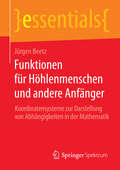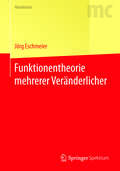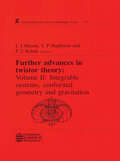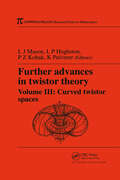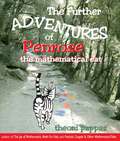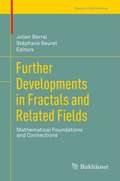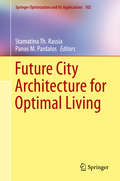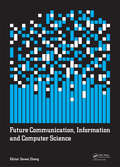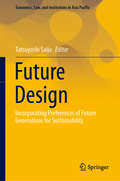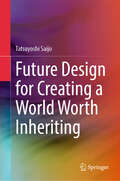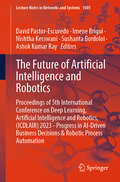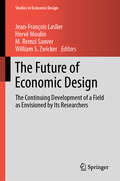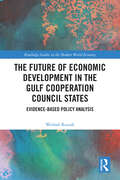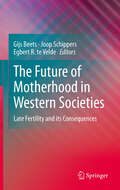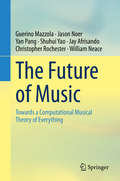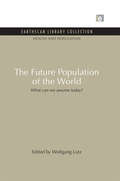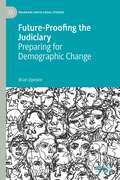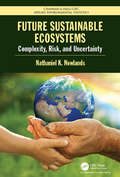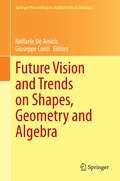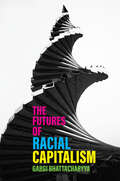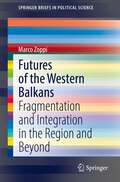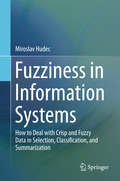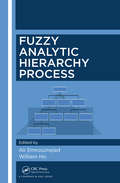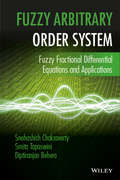- Table View
- List View
Funktionen für Höhlenmenschen und andere Anfänger: Koordinatensysteme zur Darstellung von Abhängigkeiten in der Mathematik (essentials)
by Jürgen BeetzFunktionen und Koordinatensysteme spielen in der Mathematik eine wichtige Rolle - und im täglichen Leben auch. Meist merken wir es gar nicht oder sind uns über die mathematischen Hintergründe von Grafiken gar nicht klar, die wir in den Medien sehen. Deswegen werden in diesem Essential die Grundlagen dieser bedeutenden Werkzeuge des Denkens dargestellt und ihre Verwendung illustriert. Da dazu auch ihr Missbrauch gehört, wird auch das Thema ,,Lügen mit Grafiken" behandelt: falsche Maßstäbe, Unterdrückung des Nullpunkts, unsinnige Extrapolationen und schließlich Fehler in den Zahlen selbst.
Funktionentheorie mehrerer Veränderlicher (Masterclass)
by Jörg EschmeierZiel dieses Lehrbuches ist es, einen verständlichen, möglichst direkten und in sich geschlossenen Zugang zu wichtigen Ergebnissen der mehrdimensionalen Funktionentheorie zu geben. Hierbei führt der Weg von elementaren Eigenschaften holomorpher Funktionen über analytische Mengen und Holomorphiebereiche bis hin zum Levi-Problem. Ein abschließendes Kapitel enthält mit der Konstruktion des mehrdimensionalen holomorphen Funktionalkalküls nach Shilov, Waelbroeck und Arens-Calderón und dem Satz von Arens-Royden wichtige Anwendungen auf die Theorie komplexer Banachalgebren. Zahlreiche Übungsaufgaben ergänzen den theoretischen Teil. Vorausgesetzt wird nur der Inhalt der Grundvorlesungen in Analysis und einer üblichen einsemestrigen Vorlesung über Funktionentheorie einer komplexen Veränderlichen. Das Buch richtet sich besonders an fortgeschrittene Bachelorstudierende oder Studierende eines Masterstudienganges und eignet sich bestens als Begleitlektüre zu einer Vorlesung oder auch zum Selbststudium.
Further Advances in Twistor Theory: Volume II: Integrable Systems, Conformal Geometry and Gravitation (Chapman And Hall/crc Research Notes In Mathematics Ser. #232)
by L.J. Mason L.P. Hughston P.Z. KobakTwistor theory is the remarkable mathematical framework that was discovered by Roger Penrose in the course of research into gravitation and quantum theory. It have since developed into a broad, many-faceted programme that attempts to resolve basic problems in physics by encoding the structure of physical fields and indeed space-time itself into the complex analytic geometry of twistor space. Twistor theory has important applications in diverse areas of mathematics and mathematical physics. These include powerful techniques for the solution of nonlinear equations, in particular the self-duality equations both for the Yang-Mills and the Einstein equations, new approaches to the representation theory of Lie groups, and the quasi-local definition of mass in general relativity, to name but a few. This volume and its companions comprise an abundance of new material, including an extensive collection of Twistor Newsletter articles written over a period of 15 years. These trace the development of the twistor programme and its applications over that period and offer an overview on the current status of various aspects of that programme. The articles have been written in an informal and easy-to-read style and have been arranged by the editors into chapter supplemented by detailed introductions, making each volume self-contained and accessible to graduate students and non-specialists from other fields. Volume II explores applications of flat twistor space to nonlinear problems. It contains articles on integrable or soluble nonlinear equations, conformal differential geometry, various aspects of general relativity, and the development of Penrose's quasi-local mass construction.
Further Advances in Twistor Theory, Volume III: Curved Twistor Spaces
by L.J. Mason, L.P. Hughston, P.Z. Kobak and K. PulvererAlthough twistor theory originated as an approach to the unification of quantum theory and general relativity, twistor correspondences and their generalizations have provided powerful mathematical tools for studying problems in differential geometry, nonlinear equations, and representation theory. At the same time, the theory continues to offer pro
Further Adventures of Penrose the Mathematical Cat
by Theoni PappasPenrose, no ordinary cat, takes us on an adventurous tour of mathematical concepts and characters. Now he takes off again on new adventures.Join him as he .....discovers the mathematical rep-tiles...meets x, the mathematical actor..... is overpowered by a hoard of numbers ...stumbles onto the math rods... has a close encounter with Probably... discovers how 1+1!=2 ... helps Sorry Snowflake find its symmetry ... takes on Napier's hot rods ... crosses pi's path ... learns that mathematical doughnuts are not for dunking ...tantalizes, teases and perplexes us with his puzzles and games.These amusing and informative tales are just a few of many enchanting stories written in the author's captivating style that is sure to make mathematics entertaining. The reader will gain new insights and appreciation for mathematics and its many facets.
Further Developments in Fractals and Related Fields
by Julien Barral Stéphane SeuretThis volume, following in the tradition of a similar 2010 publication by the same editors, is an outgrowth of an international conference, "Fractals and Related Fields II," held in June 2011. The book provides readers with an overview of developments in the mathematical fields related to fractals, including original research contributions as well as surveys from many of the leading experts on modern fractal theory and applications. The chapters cover fields related to fractals such as: *geometric measure theory *ergodic theory *dynamical systems *harmonic and functional analysis *number theory *probability theory Further Developments in Fractals and Related Fields is aimed at pure and applied mathematicians working in the above-mentioned areas as well as other researchers interested in discovering the fractal domain. Throughout the volume, readers will find interesting and motivating results as well as new avenues for further research.
Future City Architecture for Optimal Living (Springer Optimization and Its Applications #102)
by Stamatina Th. Rassia Panos M. PardalosThis book offers a wealth of interdisciplinary approaches to urbanization strategies in architecture centered on growing concerns about the future of cities and their impacts on essential elements of architectural optimization, livability, energy consumption and sustainability. It portrays the urban condition in architectural terms, as well as the living condition in human terms, both of which can be optimized by mathematical modeling as well as mathematical calculation and assessment.Special features include: • new research on the construction of future cities and smart cities• discussions of sustainability and new technologies designed to advance ideas to future city developmentsGraduate students and researchers in architecture, engineering, mathematical modeling, and building physics will be engaged by the contributions written by eminent international experts from a variety of disciplines including architecture, engineering, modeling, optimization, and related fields.
Future Communication, Information and Computer Science: Proceedings of the 2014 International Conference on Future Communication, Information and Computer Science (FCICS 2014), May 22-23, 2014, Beijing, China.
by Dawei ZhengThe 2014 International Conference on Future Communication, Information and Computer Science (FCICS 2014) was held May 22-23, 2014 in Beijing, China. The objective of FCICS 2014 was to provide a platform for researchers, engineers and academics as well as industrial professionals from all over the world to present their research results and development activities in Computer, Network and Information Technology and Communication Engineering.
Future Design: Incorporating Preferences of Future Generations for Sustainability (Economics, Law, and Institutions in Asia Pacific)
by Tatsuyoshi SaijoThis book discusses imaginary future generations and how current decision-making will influence those future generations. Markets and democracies focus on the present and therefore tend to make us forget that we are living in the present, with ancestors preceding and descendants succeeding us. Markets are excellent devices to equate supply and demand in the short term, but not for allocating resources between current and future generations, since future generations do not exist yet. Democracy is also not “applicable” for future generations, since citizens vote for candidates who will serve members of their, i.e., the current, generation. In order to overcome these shortcomings, the authors discusses imaginary future generations and future ministries in the context of current decision-making in fields such as the environment, urban management, forestry, water management, and finance. The idea of imaginary future generations comes from the Native American Iroquois, who had strong norms that compelled them to incorporate the interests of people seven generations ahead when making decisions.
Future Design for Creating a World Worth Inheriting
by Tatsuyoshi SaijoOur world stands at a critical crossroads. While world leaders wage wars and pursue aggression, humanity faces mounting "future failures" - burdens we're leaving for generations yet unborn. Scientists warn that carbon emissions, nitrogen cycles, and biodiversity loss have already reached dangerous tipping points. Yet we possess what we call "futurability" - the capacity to find joy in creating happiness for future generations, even at the expense of immediate gains. However, our current society isn't structured to nurture this vital human trait. Drawing inspiration from the Iroquois' seventh-generation principle, we've developed and tested innovative social mechanisms through rigorous laboratory experiments and real-world applications. This book, "Future Design for Creating a World Worth Inheriting," presents our vision and practical framework for redesigning society to activate our collective futurability. Through years of research and implementation, we've created concrete solutions that can transform how we make decisions about our shared future. Join us in this crucial endeavor to create a world our descendants will thank us for - a world truly worth inheriting.
The Future of Artificial Intelligence and Robotics: Proceedings of 5th International Conference on Deep Learning, Artificial Intelligence and Robotics, (ICDLAIR) 2023 - Progress in AI-Driven Business Decisions & Robotic Process Automation (Lecture Notes in Networks and Systems #1001)
by David Pastor-Escuredo Imene Brigui Nishtha Kesswani Sushanta Bordoloi Ashok Kumar RayThis book includes the results from the 5th International Conference on Deep Learning, Artificial Intelligence and Robotics (ICDLAIR), held in National Institute of Technology, Kurukshetra, on December 07–09, 2023, which brought together visionaries, researchers, and industry leaders at the forefront of technological innovation. In the rapidly evolving landscape of technology, deep learning, artificial intelligence, and robotics stand as a beacon of innovation and intellectual exchange. Among the myriad of groundbreaking contributions, a notable gem emerges—a forthcoming book that promises to encapsulate the essence of the 5th International Conference on Deep Learning, Artificial Intelligence and Robotics, (ICDLAIR) 2023 proceedings. Titled " Progress in AI-Driven Business Decisions & Robotic Process Automation," this publication is poised to become a cornerstone for enthusiasts, researchers, and professionals seeking a comprehensive understanding of the latest advancements in deep learning, artificial intelligence, and robotics. Focused on the theme "Progress in AI-Driven Business Decisions & Robotic Process Automation," the conference showcased groundbreaking developments in the field, exploring the intersection of deep learning, artificial intelligence (AI), and robotics.
The Future of Economic Design: The Continuing Development of a Field as Envisioned by Its Researchers (Studies in Economic Design)
by Jean-François Laslier Hervé Moulin M. Remzi Sanver William S. ZwickerThis collection of essays represents responses by over eighty scholars to an unusual request: give your high level assessment of the field of economic design, as broadly construed. Where do we come from? Where do we go from here? The book editors invited short, informal reflections expressing deeply felt but hard to demonstrate opinions, unsupported speculation, and controversial views of a kind one might not normally risk submitting for review. The contributors – both senior researchers who have shaped the field and promising, younger researchers – responded with a diverse collection of provocative pieces, including: retrospective assessments or surveys of the field; opinion papers; reflections on critical points for the development of the discipline; proposals for the immediate future; "science fiction"; and many more. The readers should have fun reading these unusual pieces – as much as the contributors enjoyed writing them.
The Future of Economic Development in the Gulf Cooperation Council States: Evidence-Based Policy Analysis (Routledge Studies in the Modern World Economy)
by Weshah RazzakThe Gulf Cooperation Council (GCC) countries own 30 percent of the world’s proven oil reserves and largely depend on oil for their income. Yet, the GCC faces serious challenges. The global demand for oil is expected to continue declining and the average long-run oil price could become lower than its historical average in the future. This book is a research–based, structural macroeconomic analysis, providing evidence-based and future-facing, policy recommendations for GCC governments. First, it analyzes historical data to explain the macroeconomic performance and economic policies of the GCC countries from 1970 to 2019. Then it presents ten-year dynamic stochastic projections from 2020 to 2030. The book examines debt sustainability and optimal fiscal policies, i.e., government spending and taxation. It also analyses structural issues such as savings and productivity, and from an institutional perspective, taking into account education, the labor market, and pension funds, as well as other factors that have a close effect on economic performance. The book is comprehensive and thorough, it relies on extensive econometric analyses, including rigorous time series analysis. The author uses both calibration of theoretical models and estimation, facilitating projections for the next decade of key economic variables under different policy scenarios. The book also assesses what the future of the GCC economies will look like if climate change and the COVID-19 pandemic continue to, adversely, affect oil supply and demand, and the price of oil, given their current policies and institutions. As well as scholars and researchers of economics and finance, the book will engage policymakers in central banks, treasury departments, planning councils, research institutes and think tanks.
The Future of Motherhood in Western Societies
by Egbert R. te Velde Gijs Beets Joop SchippersMost people value to have children still highly. But what is the optimal moment to have the first? The decision on having children or not and if yes on the timing of the first is one of the most difficult ones to make, also because it more or less coincides with various other heavy decisions on shaping the life course (like on union formation, labour market career, housing accommodation, etc.). People realise that having children will fundamentally change their life and in order to fit this unknown and irreversible adventure perfectly into their life course postponement of the first birth is an easy way out as long as doubts continue and partners try to make up their mind. Modern methods of birth control are of course a very effective help in that period. What is the best moment to have the first child? And to what moment is postponement justified? There are no easy answers to these questions. Best solutions vary per person as they depend on personal circumstances and considerations (the partner may have conflicting ideas; housing accommodation; job; income; free time activities). Existing parental leave and child care arrangements are weighted as well. Unfortunately the biological clock ticks further. And, also unfortunately, assisted reproductive technology (IVF etc.) is unable to guarantee a successful outcome. Several couples end up without children involuntarily and that may lead to sorrow and grief. This interdisciplinary book overviews the process of postponement and its backgrounds in modern Western societies holistically, both at the personal and the societal level. Contributions come from reproductive, evolutionary biological and neurological sciences, as well as from demography, economy, sociology and psychology. It holds not only at women but also at men becoming first time fathers. The discussion boils down to a new policy approach for motherhood and emancipation on how to shape work and family life? It is argued that a public window where one can compose a 'cafeteria'-like set of supportive arrangements according to personal preferences could lead to a break in the rising age at first motherhood.
The Future of Music: Towards a Computational Musical Theory of Everything
by Guerino Mazzola Yan Pang Jason Noer Shuhui Yao Jay Afrisando Christopher Rochester William NeaceThe idea of this monograph is to present an overview of decisive theoretical, computational, technological, aesthetical, artistic, economical, and sociological directions to create future music. It features a unique insight into dominant scientific and artistic new directions, which are guaranteed by the authors' prominent publications in books, software, musical, and dance productions.Applying recent research results from mathematical and computational music theory and software as well as new ideas of embodiment approaches and non-Western music cultures, this book presents new composition methods and technologies. Mathematical, computational, and semiotic models of artistic presence (imaginary time, gestural creativity) as well as strategies are also covered.This book will be of interest to composers, music technicians, and organizers in the internet-based music industry, who are offered concrete conceptual architectures and tools for their future strategies in musical creativity and production.
The Future of the Gulf Region: Value Change and Global Cycles (Gulf Studies #2)
by Arno TauschThis book studies values and attitudes in the Gulf region. In light of global power shifts, the threatening collapse of internal security in the West, and uncertainty about the current leadership vacuum in world society, this book explores a future leading role of the Gulf countries in such institutions as the G-20 and the OECD. Based on rigorous analysis of macro-level data and opinion surveys with relevance for the Gulf region, it analyzes the global macro-factors shaping the Gulf's future at a time of the global COVID-19 crisis and depression and rising global tensions. Starting with an empirical time series analysis of the long cycles of global politics and economics, it highlights the implications for the Gulf region. Offering a multivariate analysis of civil society values in the Gulf, the author analyzes value changes and attitudes on antisemitism, political Islam, internal security, democracy, and other issues of Arab politics. The partially optimistic conclusions of the study testify to the underestimated and incipient maturity of the Gulf’s civil society and strongly suggest that the Gulf's future is rather with the free societies of the West and not with a Neo-Ottoman Empire in whatever form."Exceptional in scope and right up-to-the-minute in coverage"Brian M Pollins, Associate, Professor Emeritus, The Ohio State University."An outstanding and topical book by an astute scholar of the MENA region"Professor Hussein Solomon, Academic Head of Department, Political Studies and Governance, University of the Free State, South Africa."The most comprehensive and insightful study on the subject to date"Manfred B. Steger, Professor of Sociology, University of Hawai'i at Manoa and Global Professorial Fellow, Western Sydney University.
The Future Population of the World: What can we assume today (Health and Population Set)
by Wolfgang LutzThe highly acclaimed The Future Population of the World contains the most authoritative assessment available of the extent to which population is likely to grow over the next 50 to 100 years. The book provides a thorough analysis of all the components of population change and translates these factors into a series of projections for the population of the world's regions. This revised and updated version incorporates completely new scenario projections based on updating starting values and revised assumptions, plus several methodological improvements. It also contains the best currently available information on global trends in AIDS mortality and the first ever fully probabilistic world population projections. The projections, given up to 2100, add important additional features to those of the UN and the World Bank: they show the impacts of alternative assumptions for all three components (mortality and migration, as well as fertility); they explicitly take into account possible environmental limits to growth; and, for the first time, they define confidence levels for global populations. Combining methodological innovation with overviews of the most recent data and literature, this updated edition of The Future Population of the World is sure to conform its reputation as the most comprehensive and essential publication in the field.
Future-Proofing the Judiciary: Preparing for Demographic Change (Palgrave Socio-Legal Studies)
by Brian OpeskinThis book reinvigorates the field of socio-legal inquiry examining the relationship between law and demography. Originally conceived as 'population law' in the 1960s following a growth in population and a use of law to temper population growth, this book takes a new approach by examining how population change can affect the legal system, rather than the converse. It analyses the impact of demographic change on the judicial system, with a geographic focus on Australian courts but with global insights and it raises questions about institutional structures. Through four case studies, it examines how demographic change impacts on the judicial system and how should the judicial system adapt to embody a greater preparedness for the demographic changes that lie ahead? It makes recommendations for reform and speaks to applied demographers, socio-legal scholars, and those interested in judicial institutions.
Future Sustainable Ecosystems: Complexity, Risk, and Uncertainty (Chapman & Hall/CRC Applied Environmental Statistics #11)
by Nathaniel K NewlandsFuture Sustainable Ecosystems: Complexity, Risk, Uncertainty provides an interdisciplinary, integrative overview of environmental problem-solving using statistics. It shows how statistics can be used to solve diverse environmental and socio-economic problems involving food, water, energy scarcity, and climate change risks. It synthesizes interdisciplinary theory, concepts, definitions, models and findings involved in complex global sustainability problem-solving, making it an essential guide and reference. It includes real-world examples and applications making the book accessible to a broader interdisciplinary readership. Discussions include a broad, integrated perspective on sustainability, integrated risk, multi-scale changes and impacts taking place within ecosystems worldwide. State-of-the-art statistical techniques, including Bayesian hierarchical, spatio-temporal, agent-based and game-theoretic approaches are explored. The author then focuses on the real-world integration of observational and experimental data and its use within statistical models.
Future Vision and Trends on Shapes, Geometry and Algebra
by Raffaele Amicis Giuseppe ContiMathematical algorithms are a fundamental component of Computer Aided Design and Manufacturing (CAD/CAM) systems. This book provides a bridge between algebraic geometry and geometric modelling algorithms, formulated within a computer science framework. Apart from the algebraic geometry topics covered, the entire book is based on the unifying concept of using algebraic techniques - properly specialized to solve geometric problems - to seriously improve accuracy, robustness and efficiency of CAD-systems. It provides new approaches as well as industrial applications to deform surfaces when animating virtual characters, to automatically compare images of handwritten signatures and to improve control of NC machines. This book further introduces a noteworthy representation based on 2D contours, which is essential to model the metal sheet in industrial processes. It additionally reviews applications of numerical algebraic geometry to differential equations systems with multiple solutions and bifurcations. Future Vision and Trends on Shapes, Geometry and Algebra is aimed specialists in the area of mathematics and computer science on the one hand and on the other hand at those who want to become familiar with the practical application of algebraic geometry and geometric modelling such as students, researchers and doctorates.
The Futures of Racial Capitalism
by Gargi BhattacharyyaCapitalism appears to be endlessly in crisis but without ever loosening its hold on our lives. New modes of racism and exclusion emerge, but the old ones never go away. We continue to struggle to live and survive in its wake but are unable, still now, to build commonality with each other. In this incisive book, Gargi Bhattacharyya revisits debates about racial capitalism and its violence through differentiation. Taking the four lenses of prisons, borders, debt and platforms, Bhattacharyya reveals how this moment of capitalist crisis positions humans as expendable, but differentially so, in a process that remakes longstanding racialized hierarchies. Uncovering practices and techniques embedded in the shifting processes of accumulation and state power, the chapters illuminate how value is extracted from populations through non-wage routes and indebtedness. This engaging introduction to racial capitalism offers an interlocking and insightful analysis of capitalist renewal, essential for students and scholars interested in issues of race, racism and inequality.
Futures of the Western Balkans: Fragmentation and Integration in the Region and Beyond (SpringerBriefs in Political Science)
by Marco ZoppiThis Brief provides a survey of key political, social, and economic issues affecting the Western Balkans region. Taking a two-pronged conceptual approach focusing on fragmentation and integration, the volume highlights commonalities and differences in a number of simultaneous dynamics currently characterizing the region: Europeanization and EU access, market integration, and migration and socio-demographic transformations. Stressing the interconnectedness of these issues, the volume synthesizes key questions for the future of the region, such as the relationship between socio-demographic trends and economic development, the effects of depopulation on further EU integration, and the economic and political repercussions of enhanced intra-regional trade. Explicitly interdisciplinary, this Brief will be useful for researchers and students specializing in the Balkans and Western Balkans, post-socialist countries, European affairs, enlargement, foreign policy, international relations, regional studies, economics, economic transition, and socio-demographics.
Fuzziness in Information Systems
by Miroslav HudecThis book is an essential contribution to the description of fuzziness in information systems. Usually users want to retrieve data or summarized information from a database and are interested in classifying it or building rule-based systems on it. But they are often not aware of the nature of this data and/or are unable to determine clear search criteria. The book examines theoretical and practical approaches to fuzziness in information systems based on statistical data related to territorial units. Chapter 1 discusses the theory of fuzzy sets and fuzzy logic to enable readers to understand the information presented in the book. Chapter 2 is devoted to flexible queries and includes issues like constructing fuzzy sets for query conditions, and aggregation operators for commutative and non-commutative conditions, while Chapter 3 focuses on linguistic summaries. Chapter 4 presents fuzzy logic control architecture adjusted specifically for the aims of business and governmental agencies, and shows fuzzy rules and procedures for solving inference tasks. Chapter 5 covers the fuzzification of classical relational databases with an emphasis on storing fuzzy data in classical relational databases in such a way that existing data and normal forms are not affected. This book also examines practical aspects of user-friendly interfaces for storing, updating, querying and summarizing. Lastly, Chapter 6 briefly discusses possible integration of fuzzy queries, summarization and inference related to crisp and fuzzy databases. The main target audience of the book is researchers and students working in the fields of data analysis, database design and business intelligence. As it does not go too deeply into the foundation and mathematical theory of fuzzy logic and relational algebra, it is also of interest to advanced professionals developing tailored applications based on fuzzy data.
Fuzzy Analytic Hierarchy Process
by Ali Emrouznejad William HoThis book is the first in the literature to present the state of the art and some interesting and relevant applications of the Fuzzy Analytic Hierarchy Process (FAHP). The AHP is a conceptually and mathematically simple, easily implementable, yet extremely powerful tool for group decision making and is used around the world in a wide variety of decision situations, in fields such as government, business, industry, healthcare, and education. The aim of this book is to study various fuzzy methods for dealing with the imprecise and ambiguous data in AHP. Features: First book available on FAHP. Showcases state-of-the-art developments. Contains several novel real-life applications. Provides useful insights to both academics and practitioners in making group decisions under uncertainty This book provides the necessary background to work with existing fuzzy AHP models. Once the material in this book has been mastered, the reader will be able to apply fuzzy AHP models to his or her problems for making decisions with imprecise data.
Fuzzy Arbitrary Order System: Fuzzy Fractional Differential Equations and Applications
by Snehashish Chakraverty Smita Tapaswini Diptiranjan BeheraPresents a systematic treatment of fuzzy fractional differential equations as well as newly developed computational methods to model uncertain physical problems Complete with comprehensive results and solutions, Fuzzy Arbitrary Order System: Fuzzy Fractional Differential Equations and Applications details newly developed methods of fuzzy computational techniquesneeded to model solve uncertainty. Fuzzy differential equations are solved via various analytical andnumerical methodologies, and this book presents their importance for problem solving, prototypeengineering design, and systems testing in uncertain environments. In recent years, modeling of differential equations for arbitrary and fractional order systems has been increasing in its applicability, and as such, the authors feature examples from a variety of disciplines to illustrate the practicality and importance of the methods within physics, applied mathematics, engineering, and chemistry, to name a few. The fundamentals of fractional differential equations and the basic preliminaries of fuzzy fractional differential equations are first introduced, followed by numerical solutions, comparisons of various methods, and simulated results. In addition, fuzzy ordinary, partial, linear, and nonlinear fractional differential equations are addressed to solve uncertainty in physical systems. In addition, this book features: * Basic preliminaries of fuzzy set theory, an introduction of fuzzy arbitrary order differential equations, and various analytical and numerical procedures for solving associated problems * Coverage on a variety of fuzzy fractional differential equations including structural, diffusion, and chemical problems as well as heat equations and biomathematical applications * Discussions on how to model physical problems in terms of nonprobabilistic methods and provides systematic coverage of fuzzy fractional differential equations and its applications * Uncertainties in systems and processes with a fuzzy concept Fuzzy Arbitrary Order System: Fuzzy Fractional Differential Equations and Applications is an ideal resource for practitioners, researchers, and academicians in applied mathematics, physics, biology, engineering, computer science, and chemistry who need to model uncertain physical phenomena and problems. The book is appropriate for graduate-level courses on fractional differential equations for students majoring in applied mathematics, engineering, physics, and computer science. Snehashish Chakraverty, PhD, is Professor and Head of the Department of Mathematics at the National Institute of Technology, Rourkela in India. The author of five books and approximately 140 journal articles, his research interests include mathematical modeling, machine intelligence, uncertainty modeling, numerical analysis, and differential equations. Smita Tapaswini, PhD, is Assistant Professor in the Department of Mathematics at the Kalinga Institute of Industrial Technology University in India and is also Post-Doctoral Fellow at the College of Mathematics and Statistics at Chongqing University in China. Her research interests include fuzzy differential equations, fuzzy fractional differential equations, and numerical analysis. Diptiranjan Behera, PhD, is Post-Doctoral Fellow at the Institute of Reliability Engineering in the School of Mechatronics Engineering at the University of Electronic Science and Technology of China. His current research interests include interval and fuzzy mathematics, fuzzy finite element methods, and fuzzy structural analysis.
